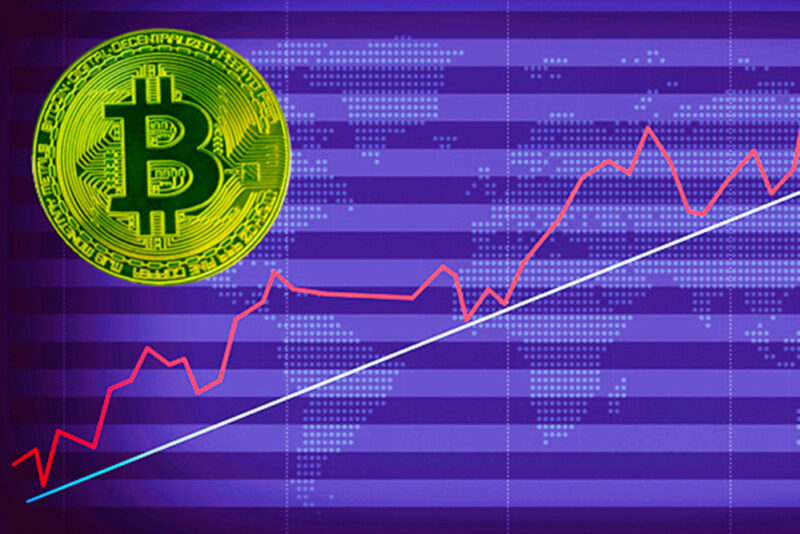The Inflation Hedge Argument
Bitcoin’s gains were extended after a survey revealed that consumer prices in the United States grew at the quickest rate in nearly four decades.
Due to its fixed supply, the biggest cryptocurrency by market value has long been regarded as an inflation hedge. In New York trade on Friday, Bitcoin (BTC) soared as high as 4.4 percent to $50,101. Because of a weekend flash crash that saw it drop as much as 21% on Saturday, the digital coin has been hovering about the $50,000 mark.
Matt Maley, the chief market strategist of Miller Tabak + Co, said, “Bitcoin is still seen as an inflation hedge, especially for younger investors.” He also added, “Since it has few restrictions right now, it is seen as a flight to safety asset for some investors.”
Because Bitcoin as well as other digital coins are a unique asset class, enthusiasts have long maintained that they can operate as hedges against volatility in other parts of the financial industry. Under the computer system that oversees issuance, only 21 million Bitcoins can be issued, though that number isn’t likely to be reached for decades.
Many prominent Wall Street analysts and investors believe that utilizing cryptocurrencies as a hedge against price increases is a good idea. Paul Tudor Jones, a veteran hedge fund manager, has previously stated that he favors it as a wealth store. Furthermore, Michael Saylor, CEO of MicroStrategy Inc., mentioned that the Federal Reserve’s loosening of its inflation strategy influenced his decision to put his company’s money into Bitcoin.
As per the Labor Department information issued Friday, the consumer price index jumped 6.8% last month, from November 2020. Those keeping a close eye on Bitcoin’s charts noticed that its increases accelerated after the data was released.
There are, however, several counter-arguments. Marc Chandler, the chief market strategist at Bannockburn Global Forex, believes that correlations aren’t always what they seem. He adds that markets surged after the release, implying that the association is with risk assets.
Others believe that Bitcoin has not been around long enough to earn its reputation as an inflation hedge. Furthermore, it behaves too much like a speculative asset, as per Cam Harvey, a Duke University professor and one of the partners at Research Affiliates, and is prone to frequent crashes.
Noelle Acheson, one of the analysts at Genesis Trading, mentioned that “If Bitcoin is ‘digital gold’ and gold is an inflation hedge, then it follows that Bitcoin is too, right? Unfortunately, there is no evidence to back this up, and even the relationship between inflation and gold has been tenuous over the years.” Acheson also wrote, “Longer term, however, gold has more than held its value while fiat currencies have declined; Bitcoin could end up doing the same.”
This high inflation rate may be seen by crypto traders as yet another reason for the Federal Reserve to speed the removal of monetary support. The Federal Reserve stated last month that it would begin tapering its $120 billion-per-month bond purchases, a type of stimulus backed by money creation aimed at helping markets and the economy recover from the effects of Covid-19.
The Fed is likely to treble the pace of tapering next week, with the goal of ending bond purchases by March rather than the current target of mid-2022. Less monetary stimulation might be negative for Bitcoin, whose price has been boosted in recent years by expectations that the Federal Reserve would print trillions of dollars, causing inflation.
Conclusion
The Consumer Price Index (CPI) of the United States, which is carefully followed by Bitcoin investors because of the cryptocurrency’s use as a hedge against inflation by various investors, has surged to its highest level since the early 1980s.
Furthermore, the CPI for all items increased 6.8% in the 12 months leading to November 2021, the highest level since May 1982, when it reached 6.9%. The cost-of-living gain was in line with experts’ average forecasts, but it was a significant jump from October’s 6.2% figure.
WeInvests is a financial portal-based research agency. We do our utmost best to offer reliable and unbiased information about crypto, finance, trading and stocks. However, we do not offer financial advice and users should always carry out their own research.
Read More













